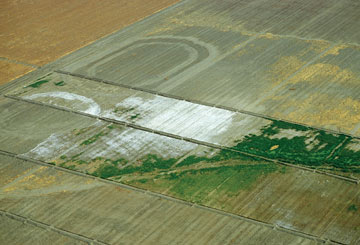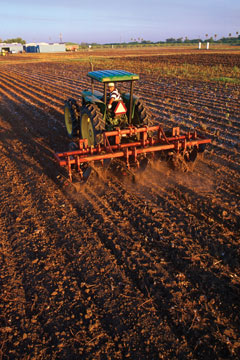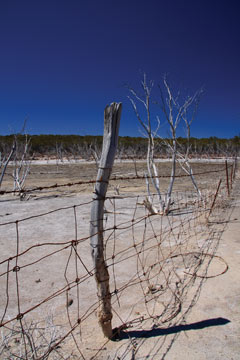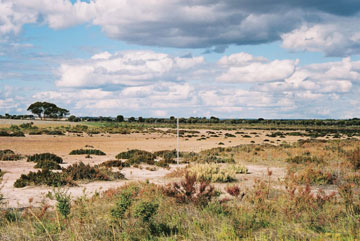|
FEATURE
Salinity in the Landscape: A Growing Problem in Australia
Pichu Rengasamy
 USDA - Scott Bauer |
| Severe salinization can ruin fields anywhere from Central California (pictured) to Australia. |
Salinization is one of the most devastating forms of land degradation threatening food production worldwide, especially in arid and semi-arid climates such as the American West and Southern Australia. In Australia, thanks to a number of factors such as climate change and irrigation practices, an increasing number of landscapes are becoming saline, causing a decreased yield of food grains. And with climate change predictions indicating less rainfall and higher temperatures in the near future in most of the agricultural regions in Southern Australia, experts worry that the changes will lead to even more saline lands and less food.
In any landscape, natural compounds derived from the physical and chemical weathering of rocks and other geological and organic materials are always present in soil layers. When soil and environmental factors contribute to the accumulation of salts above a level that impacts plant growth — including that of crops, pastures or native vegetation — as well as the health of the soil environment and the economy of the region, salinity becomes a major issue.
Problems associated with soil salinity date to the dawn of civilization. The decline of the ancient Mesopotamian civilization — the first-known society to irrigate and farm land — has been linked to decreasing soil quality due to climate change, which caused the water table to rise and become more saline, and increased irrigation. In the past two centuries, the impact of irrigation salinity on agricultural productivity has been recognized in many parts of the world, from the United States to Australia to Asia. Since the beginning of last century, the scientific study of the processes and management of soil salinity induced by irrigation has gained importance in more than a hundred countries, with pioneering work done by the U.S. Salinity Laboratory at the Department of Agriculture.
The dominant natural sources of salt are rainfall and rock weathering. Rainwater contains small amounts of salt, but over time, salt deposited by rain can accumulate. Wind-transported materials from soil or lake surfaces are another source. Poor-quality irrigation water also contributes to salt accumulation in irrigated soils. And seawater intrusion onto land, as occurred in recent tsunami-affected regions, is a growing problem. As the seas rise in many parts of the world, they can deposit huge amounts of salts in the soils of coastal lands. The particular processes contributing salt, combined with the influence of other climatic and landscape features and the effects of human activities, determine where the salt accumulates in the landscape.
 USDA - Scott Bauer |
| Farming is both a perpetrator and a victim of rising salinity in Texas (pictured) and elsewhere. |
Primary salinity is the salt accumulation that occurs naturally in soils and waters. Secondary salinity refers to salting that results from human activities, usually irrigated farming and land development. According to a 2000 report by the Food and Agriculture Organization of the United Nations, the total global area of salt-affected soils was 8.31 million square kilometers, an area that extends over every continent except Antarctica. Although the general assumption is that saline soils occur primarily in arid and semi-arid climates, these soils can be found in pretty much every climatic zone. All soil types with diverse morphological, physical, chemical and biological properties may be affected by salinity. Although different types of salts can occur in saline lands, sodium salts are predominant in many saline soils.
There are three major types of salinity found around the world, based on soil and groundwater processes: groundwater-associated salinity, transient salinity and irrigation salinity. These types are all found in Australia, where salinity is a big — and growing — problem. Australia is the driest inhabited continent with an average annual rainfall of only 42 centimeters, of which more than 80 percent is lost to evaporation. Current estimates suggest that 57,000 square kilometers of Australia’s agricultural and pastoral zones are affected by salinity induced by saline groundwater and shallow water tables. What’s worse is that the National Land and Water Resources Audit warns that unless effective solutions are implemented, that area could increase to 170,000 square kilometers (an area equivalent to three-fourths of the United Kingdom) by 2050. That’s 16 percent of Australia’s agricultural area. And transient salinity poses an even bigger problem: It currently affects 2.5 million square kilometers of Australia’s agricultural land, and is projected to impact up to 67 percent in the near future. Such changes could cost the Australian farming economy about Aus$1.33 billion per year in lost revenue.
Groundwater-associated salinity
Groundwater-associated salinity — also commonly known as “seepage salinity” and incorrectly thought of as the only form of salinity that occurs on non-irrigated land — is the scalding of soil surfaces associated with a rising saline water table. At the foot of hill slopes and in valley floors, the water table is closer to the surface than in higher elevated regions of the landscape. Under native vegetation, leaching of salts from the permeable soil due to natural processes leads to salt storage in the uppermost soil layers, or the accumulation of salts in the shallow groundwater, making it more saline. As long as the water table is at least four meters below the surface, saline groundwater does not affect native vegetation.
 Stuart Holden |
| As water tables rise closer to the surface in non-irrigated lands, the soils and the groundwater can become increasingly salty, as is happening across much of Australia’s agricultural land. |
With the clearing of perennial native vegetation and the introduction of agriculture in Australia, the equilibrium of the water table changes. Groundwater levels rise as pastures and annual crops replace native vegetation. This leads to less evaporation and transpiration (evapotranspiration) than occurs under the natural system. As the saline groundwater rises to the surface, soil layers in the top one meter become salinized and waterlogged. Salts reach the surface in the discharge zones (areas where water exits from groundwater to the soil surface) by the capillary rise of the groundwater.
Transient salinity
Under semi-arid conditions, rainfall is insufficient to leach all the salts accumulated below the root zones of native vegetation to the deep groundwater and the clay layers in deep subsoils hinder the movement of water and salt. As a result, a salt “bulge” can accumulate in the soil layers approximately four to 10 meters below the surface, but because the water table is generally at least 30 meters below the surface, its quality is classified as “not very saline.” This is different from the situation at the foot of slopes and in valley floors, where water tables are shallow and groundwater processes cause soil salinity. Recent geophysical studies using modern techniques such as airborne electro-magnetics have confirmed the occurrence of salt bulges in deeper soil layers in many landscapes in Australia.
Because of the salt’s movement through soil layers, more than 60 percent of the soils in agricultural zones in Australia have become “sodic.” Dense sodic subsoils prevent water transmission and restrict leaching — a process that has led to salt accumulation in subsoils (root zone layers) in amounts detrimental to plant growth. This “transient salinity” fluctuates with depth and its concentration and effect on plant growth changes with season and rainfall. Groundwater processes do not influence this form of salinity.
Irrigation salinity
Irrigation in Australia has been developed over a wide range of climatic zones, from Mediterranean climates to tropical and subtropical climates. The quality of water from rivers used for irrigation is usually good with a very low salt content. However, discharge of effluents and drainage waters into the rivers from these fields or from industrial and residential inputs tends to increase the salinity of the river water. This is particularly problematic in Southern Australia, especially during the dry summer and when the water flow is reduced.
 Georgina Wilson, Western Australian Department of Agriculture |
| Crop production is severely affected by salt in Western Australia. |
Most of the irrigated soils are sodic, with low water permeability increasing the probability of salt buildup over time. Furthermore, because the landscape in irrigation areas tends to be flat, recharge of water leads to an increase in water table levels, which is troublesome in areas with groundwater that is already saline. Lack of drainage schemes, which would help avert a shallow water table, thus exacerbates salinity under irrigation. Subsequent efforts to pump the saline groundwater to reduce water table levels and to promote reuse of the groundwater for irrigation can then result in the salinization of the soil layers. Where leaching is sufficient, the soils become sodic. We’re already seeing this in Australia. A recent trend in using industrial effluents (with high pH and salinity) and recycled water for irrigation unfortunately also promotes soil salinization and sodification.
Climate change and salinity
In many non-irrigated regions in the world, the extent and nature of salinity is influenced by a range of soil processes and climatic conditions. The major factors include the amount and frequency of rainfall, evapotranspiration (caused by climatic factors), water use by vegetation and how water moves through the soil. So in areas where lower rainfall and higher temperatures are predicted because of global warming, the change will be toward a more arid climate, which is conducive to salt accumulation. Lack of organic matter caused by drier climate can lead to further deterioration of the soil structure, which reduces the ease with which salts can be leached from the soil profile. Conversely, in areas where the changing climate is predicted to bring increased rainfall and lower temperatures, there may be less salt accumulation, which can thus reduce salinization. If only it were that simple. Unfortunately, the climate-soil interaction tends to make things more complicated.
In locations where salinity is caused by perturbed groundwater levels, higher rainfall and lower temperatures can enhance the groundwater perturbations, leading to an increase in soil salinity. A change to drier climates in this kind of system, though, can result in reduction of salinity levels in soil surfaces.
While predictions on long-term climate change in Australia vary depending on the model, the general assumption is that most of the agricultural regions in Southern Australia will experience lower rainfall, particularly in winter, and higher temperatures in summer. These conditions will be conducive for increasing salinization of productive lands. Decreasing water availability for crops due to low rainfall and salinity will force agricultural activities to move toward Northern Australia where high rainfall is expected to continue.
Combating salinity
On marginal soils with moderate levels of salts, farming various crops can be viable if appropriate species are selected and careful management is practiced. Additionally, there are ways to combat salinity, primarily through sustainable agriculture. Exactly which tack to take, however, depends on the salt concentrations in the soil and groundwater. Management of soil factors to reduce the salt levels and cultivating crop species that are tolerant of the given level of salinity are available options.
Soil management will include: Managing salinity levels by managing groundwater balance; preventing salt accumulation by improving soil condition to allow leaching of salts from soil layers; and choosing the appropriate quality of irrigation water and the amount to be used in irrigated areas to avoid salt buildup.
Experiments conducted in different parts of Australia, both in irrigated and non-irrigated agriculture, have shown that applying gypsum and improving organic matter in soils will increase water movement in soils and reduce salt accumulation. In areas where salinity is induced by a rising water table, growing deep-rooted plants can increase evapotranspiration and increase the depth of the water table to maintain a critical level. Several guidelines have been developed for irrigated crops to ensure the use of appropriate irrigation water and methods of irrigation.
Additionally, there is the possibility of introducing crops that have been genetically modified in an attempt to raise the salt tolerance, but experiments have been largely disappointing thus far. Salt tolerance of crops is complex both genetically and physiologically. Investigations on which genes allow some plants to survive in high salt and drought while others die, and understanding the functions in specific cells that enable salinity tolerance may lead to genetic engineering of crops suitable for saline lands.
The threat of climate change causing salinization of currently flourishing agricultural lands increases the necessity to find ways of combating salinity — or we’ll just have to find ways to live with it.

 Subscribe
Subscribe


